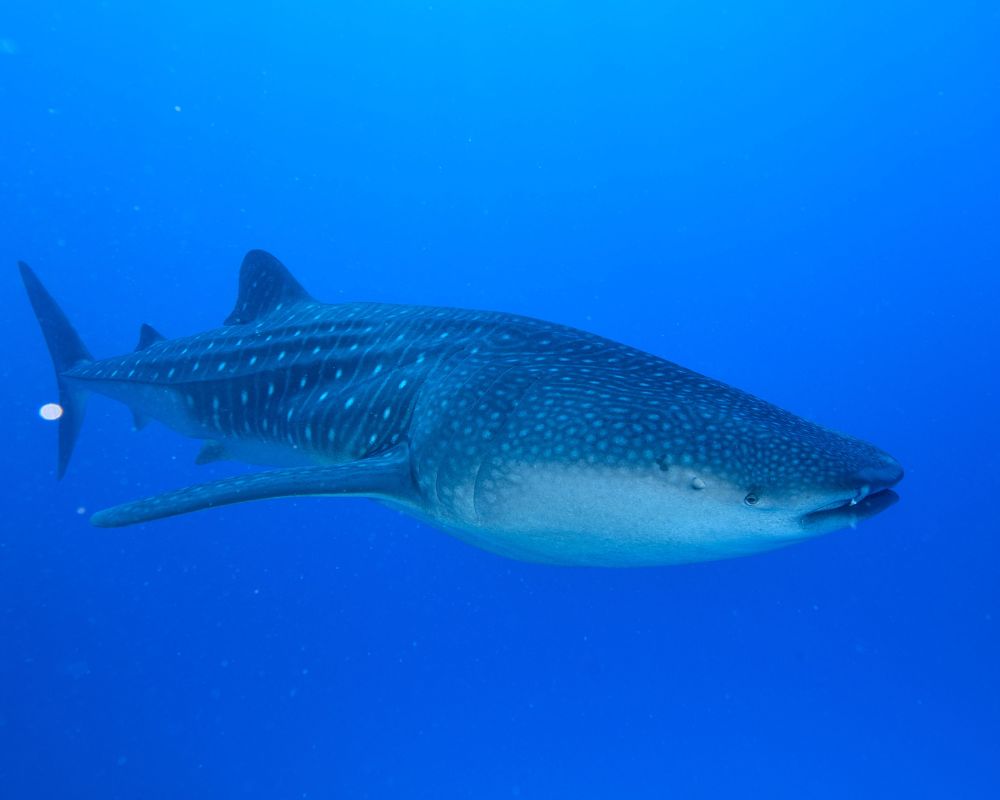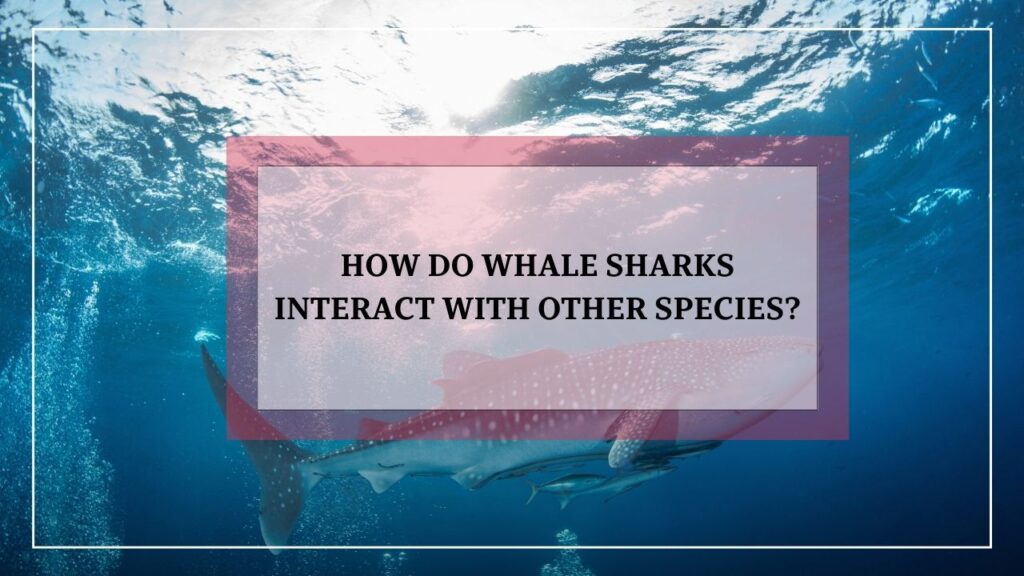Have you ever wondered what it’s like to swim with the giants of the sea? Picture yourself surrounded by creatures as long as a school bus, with mesmerizing patterns adorning their skin. These creatures are whale sharks, the largest fish species in the world.
Whale sharks are fascinating not only for their impressive size but also for their interactions with other marine species. In this blog post, we’ll explore the ins and outs of how whale sharks interact with other species, from filter-feeding on plankton to swimming with manta rays.
Whale sharks interact with other species through filter-feeding on plankton, predator-prey interactions, and commensalism/mutualism relationships. They play a vital role in maintaining the health of the marine ecosystem, and understanding their interactions is crucial for conservation efforts.
Don’t worry, we will explain each type of these interaction further throughout our blog post. Keep following:
Interactions Of Whale Sharks with Other Marine Species

Whale sharks are not solitary creatures; they interact with a variety of marine species in different ways. Let’s take a closer look at some of these interactions:
Filter-Feeding Interactions
Filter-feeding is the primary way that whale sharks interact with other species. These gentle giants are filter feeders, which means they consume tiny planktonic organisms as their main food source. Here’s how they do it:
- Types Of Plankton: Whale sharks primarily feed on two types of plankton – zooplankton and phytoplankton. Zooplankton consists of tiny animals such as shrimp, krill, and fish larvae, while phytoplankton consists of tiny plants such as algae and diatoms.
- Locating Plankton: Whale sharks use a combination of visual and sensory cues to locate plankton. They have tiny sensory organs called ampullae of Lorenzini that can detect electrical fields in the water. They also have a keen sense of smell and can follow scent trails to locate plankton.
- Creating A Vortex: Once a whale shark has located a patch of plankton, it will begin to swim in a circular motion while opening its mouth. This creates a vortex that pulls water, and plankton, into the mouth.
- Role Of Plankton: Zooplankton and phytoplankton are critical components of the marine ecosystem. They are the base of the food chain and provide food for many other marine species.
Predator-Prey Interactions
Although whale sharks are massive creatures, they are not invulnerable. They have predators and interact with other marine species in predator-prey relationships. Here’s what happens:
- Predators: Whale sharks have few natural predators, but they can fall victim to sharks, killer whales, and humans. However, because of their size, agility, and thick skin, they can often evade predators.
- Avoidance Techniques: When faced with a potential predator, whale sharks will often dive deep or change direction quickly to evade them. They can also use their large size to intimidate predators.
- Role In Ecosystem: Despite their relatively low predation risk, whale sharks play a vital role in maintaining the health of the marine ecosystem. As filter feeders, they help control the populations of small organisms such as plankton, which in turn affects the entire food chain.
Commensalism and Mutualism Interactions
In addition to filter-feeding and predator-prey interactions, whale sharks also engage in commensalism and mutualism relationships with other marine species. Let’s take a closer look at these interactions:
What Is Commensalism And Mutualism?
Before we dive into the specific interactions between whale sharks and other species, it’s essential to define commensalism and mutualism:
- Commensalism: A commensal relationship is where one species benefits from the association, while the other is neither helped nor harmed. For example, barnacles attach themselves to the skin of whales or turtle shells.
- Mutualism: A mutualistic relationship is where both species benefit from the association. This relationship may or may not be essential for survival.
Habitat For Other Marine Species
Whale sharks provide a habitat for various marine species, including remoras and pilot fish. These species attach themselves to the whale shark’s skin and feed on the parasites and dead skin cells.
- Remoras: Remoras are a type of fish that attach themselves to the skin of whale sharks. They use the shark as transportation and feed on parasites and dead skin cells.
- PilotFish: Pilotfish also live in close proximity to whale sharks, swimming alongside or underneath them. These small fish feed on leftover scraps of food that the whale shark misses, and in return, provide a cleaning service by removing dead skin and parasites from the shark’s body.
Benefits Of Living With Whale Sharks
The commensalism and mutualism relationships between whale sharks and these species are beneficial for both parties involved:
- Benefits For The Marine Species: Remoras and pilot fish receive a constant source of food and a safe place to live. They also receive protection from larger predators when they are in close proximity to the whale shark.
- Benefits For Whale Sharks: The presence of these species may provide some protection for the whale shark against parasites or infection. Additionally, the removal of dead skin and parasites can help keep the whale shark’s skin healthy and clean.
How Do Whale Sharks Communicate?
Whale sharks are social creatures that often travel in groups, so it’s essential to understand how they communicate with one another. While they may not use vocalizations like some other marine animals, they do communicate in various ways.
Body Language
One of the most common ways that whale sharks communicate is through body language. They use specific body postures, movements, and behaviors to convey messages to other whale sharks. For example:
- Tail Slap: When a whale shark slaps its tail against the water’s surface, it may be communicating distress or trying to signal to other whale sharks in the area.
- Pectoral Fin Extension: Whale sharks may extend their pectoral fins out to the sides when they are swimming near one another. This behavior may indicate a desire to mate or form a social bond.
Chemical Signals
Whale sharks also communicate using chemical signals, which they release into the water through their skin or feces. These chemicals can convey information about the whale shark’s sex, age, and reproductive status. They can also use chemical signals to find potential mates or detect prey.
Visual Displays
In addition to body language, whale sharks use visual displays to communicate with one another. For example:
- Color Changes: Whale sharks have the ability to change the color of their skin. They may darken or lighten their skin to signal aggression, submission, or other messages to other whale sharks.
- Gape Displays: When a whale shark opens its mouth wide, it may be trying to intimidate a potential predator or show off to a potential mate.
The Bottom Line
In conclusion, while much is still unknown about how whale sharks interact and communicate with other species, researchers have identified a number of behaviors and physiological adaptations that suggest these gentle giants are able to navigate complex social and ecological systems.
From synchronized feeding to symbiotic relationships with fish, whale sharks demonstrate an impressive ability to cooperate and communicate with a diverse range of other marine organisms. Continued research into these fascinating creatures is sure to uncover even more insights into their unique place in the ocean ecosystem.

